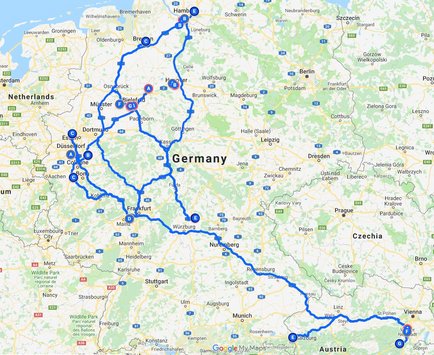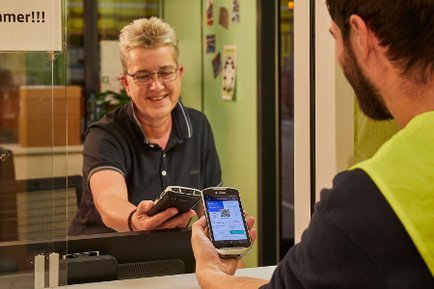06.12.2018
Realistic test conditions
As mentioned in a previous blog post, one of the major challenges was how to represent a real-life supply chain. We wanted our blockchain pilot to differ from other projects by involving a large network of business partners and test conditions that came as near to real life as possible. Together with project participants, we conducted the largest, practical, inter-company blockchain test in Germany:
- establishment of a decentralised network comprising 13 external nodes belonging to the different project participants
- 17 participants in the field test, with a total of 20 different warehouse locations
- insistence on real supply-chain relationships
- test carried out using real goods, real pallets, real employees, real loading bays, real lorries and real data
Preparing for the test
We equipped all of the industrial and retail partners with two hand-held devices and accessories. One hand-held device for the employee in the outgoing/incoming goods department, and one hand-held device for the driver. Normally, however, if the solution were to be rolled out, truck drivers would carry the hand-held device with them, or open the app in their smartphone. For security reasons, the devices used in the pilot project were supplied on the test sites belonging to our industry and retail partners. It was also important to equip the devices with a SIM card because some companies were unable to connect to a Wi-Fi network. This was one way of ensuring that all test participants were able to use the mobile blockchain-based application. Besides the equipment, another key focus of the project was the online training on how to use the mobile app and pallet portal. Our aim here was to provide interactive training and enable two-way communication between SAP and the trainees. Finally, all field test participants were provided with a user information pack for the internal employee training, as well as information specifically for the driver training, together with login details.
Before the test was launched, all participants had to validate the following points:
- mobile end device available
- mobile end device fully charged and ready for use
- mobile device can be switched on
- login works (for every user taking part in the test)
- QR code scanner is working/access to camera enabled
- network connection available on the test site/access to Wi-Fi network possible
Conducting the test: description of the exchange process
The field test was carried out between 15 and 30 October 2018 and was conducted parallel to the companies’ normal operations. This ensured that all data was recorded on both paper (the pallet note) and in the mobile app. As mentioned above, two mobile hand-held devices were provided, one for Outgoing Goods (OG) and one for Incoming Goods (IG). When an exchange partner logs into the exchange app, their master data is automatically stored and a QR code, which contains all the key information about their company.
At the beginning the participants register in the exchange app. The OG/IG employee creates a new pallet exchange transaction and identifies the exchange partner by scanning the QR code on the driver’s device. The OG/IG employee then enters the pallets that have been unloaded and loaded in the pallet app. The app also allows users to enter a reference number (e.g. delivery note number) and a reason to explain any difference in the number of pallets. The information entered will then be sent to the driver. The driver can see the partner’s exchange request under ‘Open transactions’ and clicks on this to view. If the driver agrees with the data entered, he clicks to confirm and the data set is saved in the blockchain. In the event that the driver disagrees with the data entered, he has the possibility to change the data and send the partner a new exchange request. The employee in OG/IG must confirm the amendment in order to save the data to the blockchain.
The employees in the load carrier management, who are responsible for typing out pallet notes every single day so that the pallet account can be tracked in Excel or some other software, now has the opportunity to view all the exchange transactions in the pallet portal. The summary shows open transactions, as well as transactions that have already been closed. In another tab, labelled ‘Balance’, employees can see all balances for every type of load carrier. By selecting a type of load carrier, a list of all exchange partners is displayed, together with the corresponding balance. Besides the ‘Balance’ tab, there is also a summary of any requests for corrections or balance settlements. ‘New correction requests’ and ‘New balance settlements’ are both listed separately.
Findings and insights:
Besides putting blockchain thoroughly through its paces, there was one specific issue that participants wanted to focus on: Can blockchain put an end to the paper-pushing involved in the pallet exchange process? The answer is yes, albeit under certain conditions.
As a general rule, the pallet note can be reproduced digitally using the blockchain app. The test proved the potential to optimise the outdated, cumbersome and inefficient pallet exchange process and manage the process with a mobile app. Users confirmed that the graphic user interface had a good level of operational functionality, was user-friendly and clearly laid out. However, training is a must in order to familiarise employees with the new process early on.
At the beginning of the field test, drivers proved to be a significant challenge in the exchange process because these were often eastern Europeans who had not received enough training. This led to drivers who had little confidence in the technology and who were apprehensive about entering and/or confirming data in the mobile app. Drivers are a key weak point in the process and represent a bottleneck.
As a general rule, the mobile app contains all the essential functions. However, participants believe that additional features would be useful, such as the possibility to save preferred exchange partners, attach photos, integrate other load carriers, etc. This goes to show that there is huge potential for enhancing the app.
To conclude, it is clear to say that the greatest added value is not only created by processing transactions in real time, but also – and more importantly – by the downstream processes associated with pallet notes. Manual procedures such as entering pallet notes, managing pallet accounts and posting to the ERP system are no longer needed. The number of errors in the paperwork also decreases because deciphering hand-written comments is a thing of the past. We also received this feedback from participants: “A significant gain in efficiency can be seen primarily in the back office, due to simplified account reconciliation and automated balance calculations.”





Comments
No Comments